AMD Ryzen 9 5980HS Cezanne Review: Ryzen 5000 Mobile Tested
by Dr. Ian Cutress on January 26, 2021 9:00 AM EST- Posted in
- CPUs
- AMD
- Vega
- Ryzen
- Zen 3
- Renoir
- Notebook
- Ryzen 9 5980HS
- Ryzen 5000 Mobile
- Cezanne
CPU Tests: Encoding
One of the interesting elements on modern processors is encoding performance. This covers two main areas: encryption/decryption for secure data transfer, and video transcoding from one video format to another.
In the encrypt/decrypt scenario, how data is transferred and by what mechanism is pertinent to on-the-fly encryption of sensitive data - a process by which more modern devices are leaning to for software security.
Video transcoding as a tool to adjust the quality, file size and resolution of a video file has boomed in recent years, such as providing the optimum video for devices before consumption, or for game streamers who are wanting to upload the output from their video camera in real-time. As we move into live 3D video, this task will only get more strenuous, and it turns out that the performance of certain algorithms is a function of the input/output of the content.
HandBrake 1.32: Link
Video transcoding (both encode and decode) is a hot topic in performance metrics as more and more content is being created. First consideration is the standard in which the video is encoded, which can be lossless or lossy, trade performance for file-size, trade quality for file-size, or all of the above can increase encoding rates to help accelerate decoding rates. Alongside Google's favorite codecs, VP9 and AV1, there are others that are prominent: H264, the older codec, is practically everywhere and is designed to be optimized for 1080p video, and HEVC (or H.265) that is aimed to provide the same quality as H264 but at a lower file-size (or better quality for the same size). HEVC is important as 4K is streamed over the air, meaning less bits need to be transferred for the same quality content. There are other codecs coming to market designed for specific use cases all the time.
Handbrake is a favored tool for transcoding, with the later versions using copious amounts of newer APIs to take advantage of co-processors, like GPUs. It is available on Windows via an interface or can be accessed through the command-line, with the latter making our testing easier, with a redirection operator for the console output.
We take the compiled version of this 16-minute YouTube video about Russian CPUs at 1080p30 h264 and convert into three different files: (1) 480p30 ‘Discord’, (2) 720p30 ‘YouTube’, and (3) 4K60 HEVC.
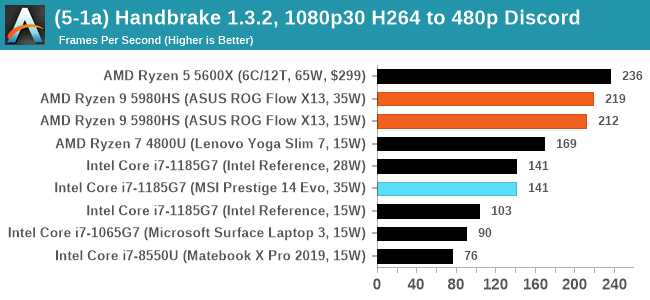
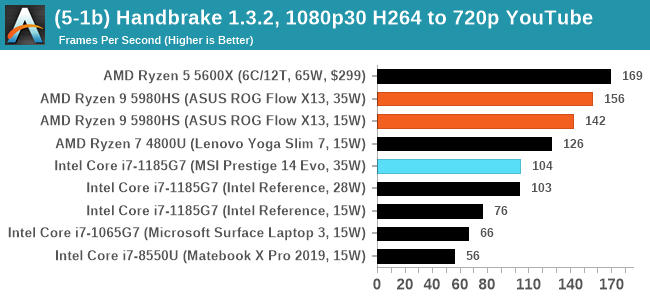
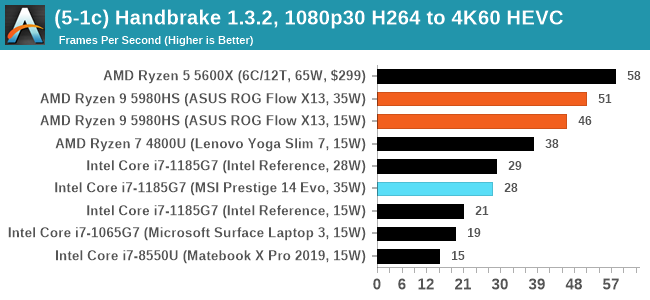
Threads wins, although the +30W difference to the desktop processor with two fewer cores can't be overhauled. Almost though.
7-Zip 1900: Link
The first compression benchmark tool we use is the open-source 7-zip, which typically offers good scaling across multiple cores. 7-zip is the compression tool most cited by readers as one they would rather see benchmarks on, and the program includes a built-in benchmark tool for both compression and decompression.
The tool can either be run from inside the software or through the command line. We take the latter route as it is easier to automate, obtain results, and put through our process. The command line flags available offer an option for repeated runs, and the output provides the average automatically through the console. We direct this output into a text file and regex the required values for compression, decompression, and a combined score.
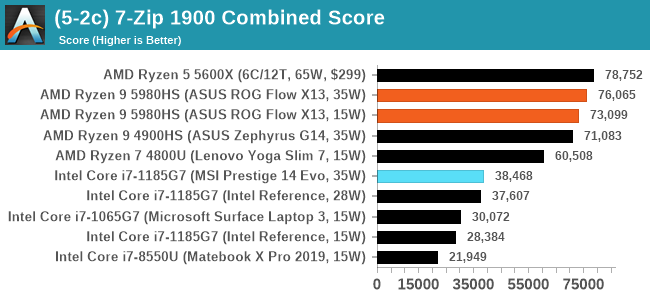
AES Encoding
Algorithms using AES coding have spread far and wide as a ubiquitous tool for encryption. Again, this is another CPU limited test, and modern CPUs have special AES pathways to accelerate their performance. We often see scaling in both frequency and cores with this benchmark. We use the latest version of TrueCrypt and run its benchmark mode over 1GB of in-DRAM data. Results shown are the GB/s average of encryption and decryption.
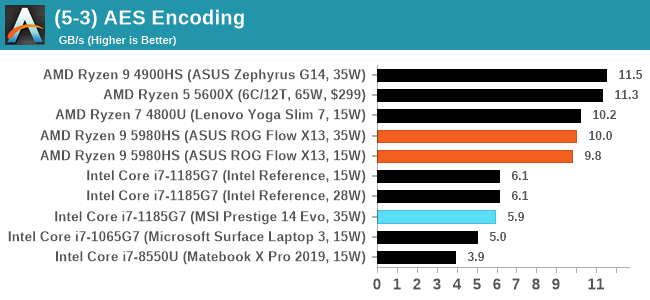
For our AES test here we actually had a small regression in performance. This could mean that there is additional performance hits to accessing the AES unit this time around, or the lower latency DDR4 of the Zephyrus is beating out the LPDDR4 on our Flow X13.
WinRAR 5.90: Link
For the 2020 test suite, we move to the latest version of WinRAR in our compression test. WinRAR in some quarters is more user friendly that 7-Zip, hence its inclusion. Rather than use a benchmark mode as we did with 7-Zip, here we take a set of files representative of a generic stack
- 33 video files , each 30 seconds, in 1.37 GB,
- 2834 smaller website files in 370 folders in 150 MB,
- 100 Beat Saber music tracks and input files, for 451 MB
This is a mixture of compressible and incompressible formats. The results shown are the time taken to encode the file. Due to DRAM caching, we run the test for 20 minutes times and take the average of the last five runs when the benchmark is in a steady state.
For automation, we use AHK’s internal timing tools from initiating the workload until the window closes signifying the end. This means the results are contained within AHK, with an average of the last 5 results being easy enough to calculate.

Another small performance uplift for WinRAR.


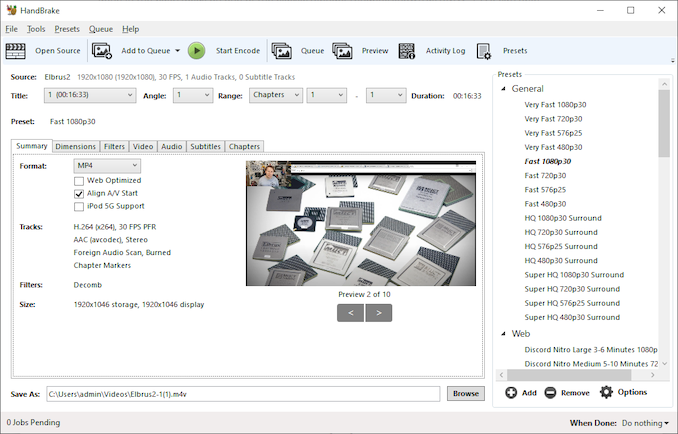
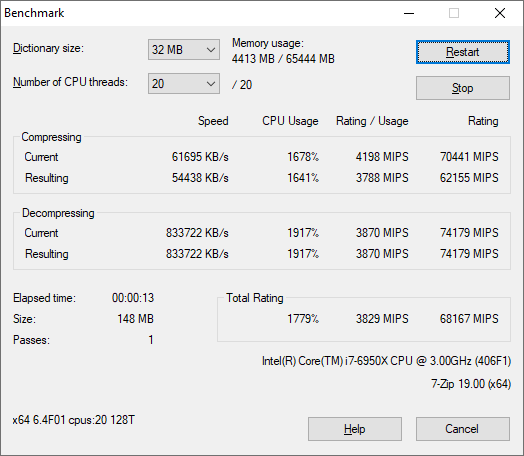









218 Comments
View All Comments
Smell This - Tuesday, January 26, 2021 - link
LOL @ ZoZo ___ he is messin' with you, ts
You are correct in that Dr Su and AMD has played yet another "Rope-A-Dope" on the competition. I suspect RDNA2/Navi II will raise its pretty head after the "Lexa" cores run their course. It has been a productive run.
There are Radeon pro CNDA1 cores floating around that will likely evolve into the RX 6500 RDNA2/Navi IIs discreet replacements for Lexa. These will be the Display Core Next: 3.0 // Video Core Next: 3.0 arch associated with the Big Navi.
And ... I don't think AMD is being lazy. I think the Zen2/Zen3 APU product stack is being developed as yet to be revealed. Home / Office / Creator ? There is a Radeon Pro Mac Navi Mobile with RDNA1 discreet video w/HBM2.
We will see how the 6xxx APUs evolve. Grab your popcorn!
TelstarTOS - Tuesday, January 26, 2021 - link
lazy, definitely lazy.vortmax2 - Saturday, January 30, 2021 - link
One sees lazy, another sees smart business decision.samal90 - Friday, February 12, 2021 - link
The APU in 2022 will use RDNA 2 finally. Expect a substantial GPU performance lift next year with the new Rembrandt chip.Spunjji - Thursday, January 28, 2021 - link
A console APU is not a PC APU - they have completely different design constraints and memory architectures. Vega was used here because it allowed AMD to bring Zen 3 APUs to market faster than they managed with Zen 2 - it's all mentioned in the review that you're commenting on......sandeep_r_89 - Friday, January 29, 2021 - link
The consoles don't use iGPUs.......most likely, RDNA2 design so far hasn't been designed for low power usage, it's focused more on high performance. Once they do the work to create a low power version, it can appear in iGPUs, laptop dGPUs, low end desktop dGPUs etc.Netmsm - Tuesday, January 26, 2021 - link
any hope for Intel?Deicidium369 - Wednesday, January 27, 2021 - link
LOL. Any hope for AMD?Releases Zen 3, RDNA2 and consoles - and only grows revenue $240M over Q3.... Didn't even gross $10B last year.
Meanwhile Intel posts 5 YEARS of record growth...
Spunjji - Thursday, January 28, 2021 - link
A discussion of a company's technological competitiveness is not a discussion of their financial health. Any dolt knows this, why do you pretend we can't see you moving the goalposts in *every single comment section*?Spunjji - Thursday, January 28, 2021 - link
This post is even more hilarious in the context of AMD's financial disclosure today 😁